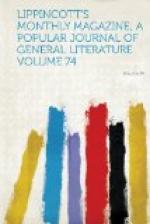This kind of literary union, the long-continued conjunction of two kindred spirits, is better understood amongst us than the indiscriminate collaboration which marks the dramatic career of M. Eugene Labiche, for instance. Both kinds were usual enough on the English stage in the days of Elizabeth, but we can recall the ever-memorable example of Beaumont and Fletcher, while we forget the chance associations of Marston, Dekker, Chapman and Ben Jonson. And in contemporary literature we have before us the French tales of MM. Erckmann-Chatrian and the English novels of Messrs. Besant and Rice. The fact that such a union endures is proof that it is advantageous. A long-lasting collaboration like this of MM. Meilhac and Halevy must needs be the result of a strong sympathy and a sharp contrast of character, as well as of the possession by one of literary qualities which supplement those of the other.
One of the first things noticed by an American student of French dramatic literature is that the chief Parisian critics generally refer to the joint work of these two writers as the plays of M. Meilhac, leaving M. Halevy altogether in the shade. At first this seems a curious injustice, but the reason is not far to seek. It is not that M. Halevy is some two years the junior of M. Meilhac: it lies in the quality of their respective abilities. M. Meilhac has the more masculine style, and so the literary progeny of the couple bear rather his name than his associate’s. M. Meilhac has the strength of marked individuality, he has a style of his own, one can tell his touch; while M. Halevy is merely a clever French dramatist of the more conventional pattern. This we detect by considering the plays which each has put forth alone and unaided by the other. In reading one of M. Meilhac’s works we should feel no doubt as to the author, while M. Halevy’s clever pictures of Parisian society, wanting in personal distinctiveness, would impress us simply as a product of the “Modern French School.”




